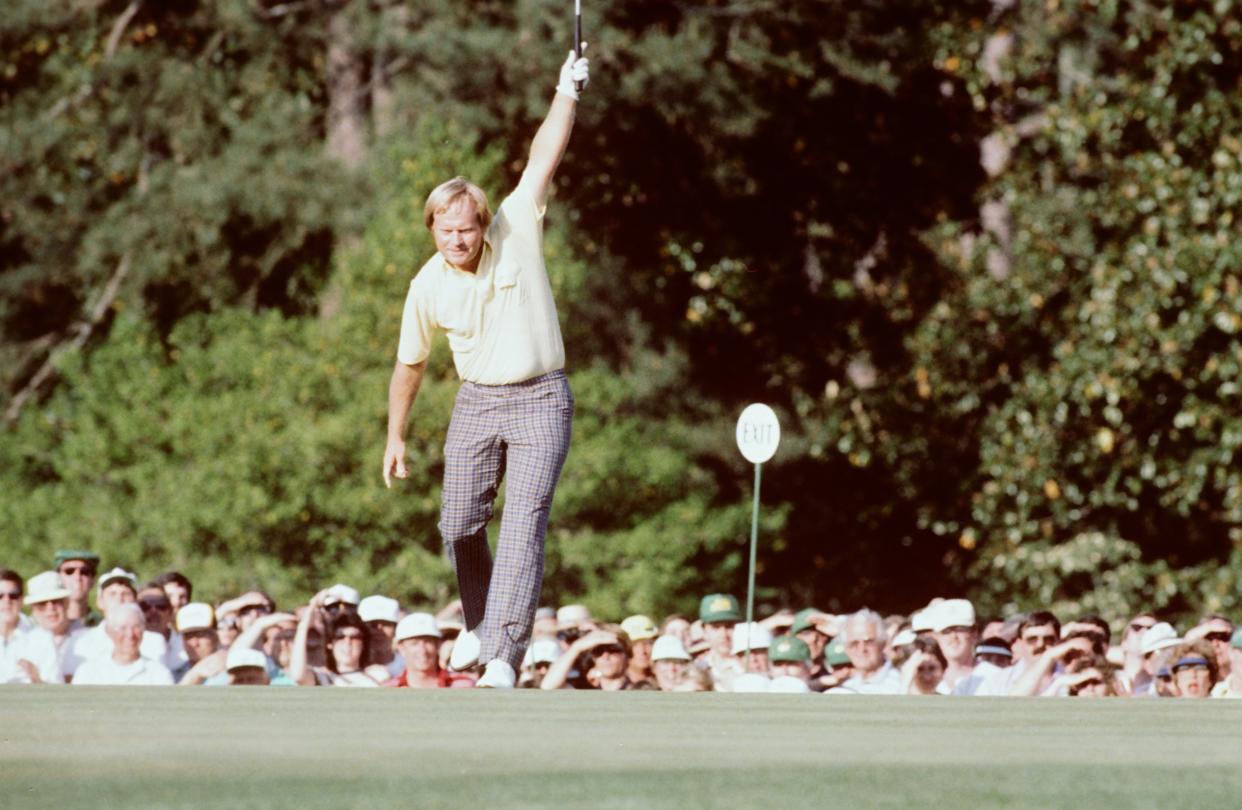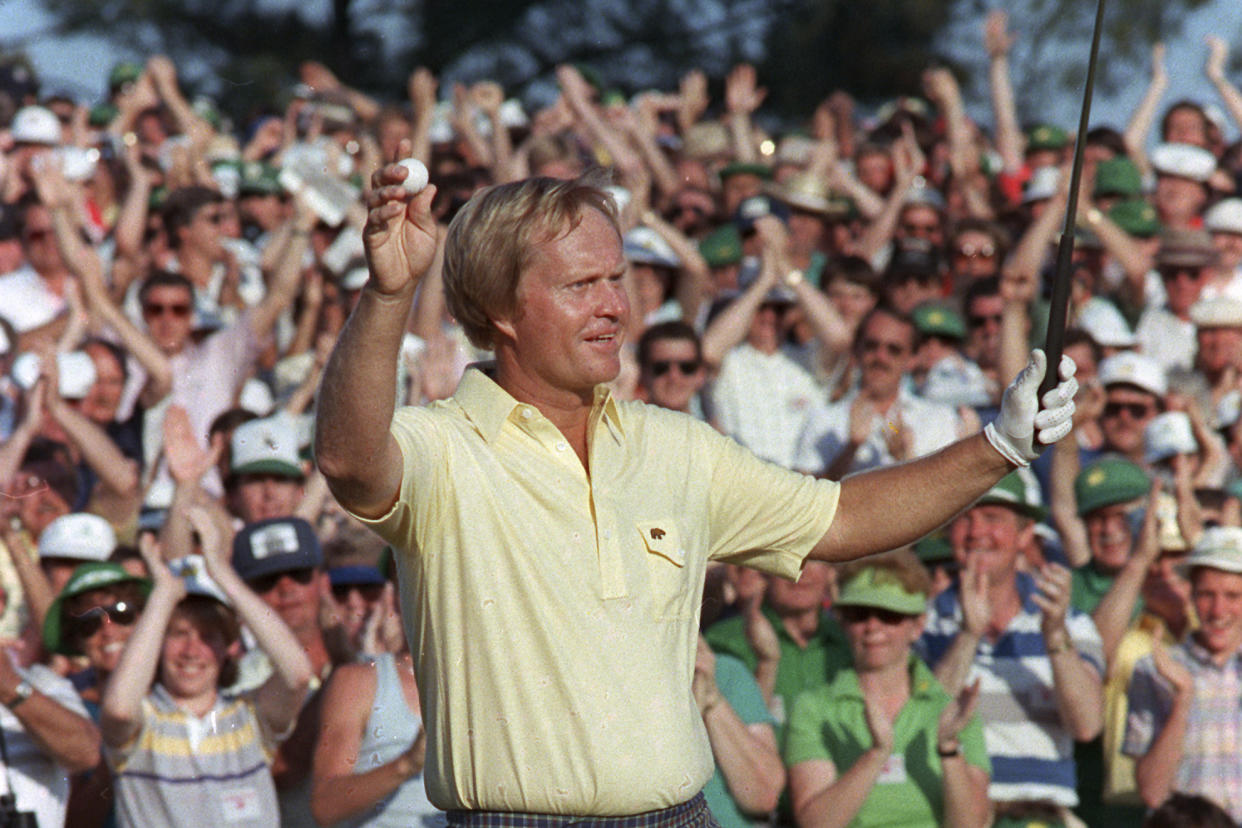Masters 2023: What happened to Jack Nicklaus' famous yellow 1986 Masters shirt?

AUGUSTA, Ga. — Jack Nicklaus woke up in his Augusta rental house on the morning of April 13, 1986, without a care in the world. Hours away from teeing off in the final round of that year’s Masters, he was four shots behind Greg Norman, with another 13 players either tied with or ahead of him. This would be a pleasant day on one of his favorite courses, nothing more.
Nicklaus dug through his suitcase and found a tailored yellow shirt — pointed collars, long placket, Golden Bear logo on the closing flap of the left pocket. One of a dozen, maybe a hundred, that Nicklaus owned in a range of hues. Choice made, he and his wife Barbara left the house for Augusta National.
A few hours later, that yellow shirt would match perfectly with the green jacket draped over it.
The shot of Nicklaus raising his putter in victory on that famous day in 1986 remains an indelible image, one of the most memorable in sports history. The glowing yellow shirt burned its way into the heart of everyone watching that day. In the wake of Nicklaus’ final major victory, the color yellow became his symbol and the inspiration for a charitable effort that’s nearly reached nine figures.
So what happened to the shirt that started it all? To get there, we need to go back in time more than 50 years, to Nicklaus’ hometown of Columbus, Ohio, in 1968, to the home of a boy named Craig Smith.
The story behind the color yellow
Craig was an energetic 10-year-old with a surpassing love of golf. Growing up in the 1960s in Columbus, he idolized Nicklaus. Craig’s father, Reverend Dr. William E. Smith, was the pastor at the Methodist church Barbara Nicklaus attended, and Jack spent many afternoons at the Smith home, sharing Cokes and a love of golf with young Craig.
Nicklaus at that time was in the process of claiming the golf world as his own, winning the first of what would be 18 majors. Craig, meanwhile, would spend hours in his backyard chipping balls, trying to learn the secrets of a game that Nicklaus had already mastered.
One day, while walking to school, Craig collapsed, his leg in agony. A diagnosis was as grim as it gets: Ewing’s sarcoma. Bone cancer. Doctors gave him six months to live. Nicklaus did all he could to lift Craig’s spirits, sending him inspirational notes and souvenirs from his tournaments.
“Once, after a tournament victory, I was on the phone with Craig,” Nicklaus told Yahoo Sports this week. “He said that he knew I would win because he was wearing his lucky yellow shirt.”
An idea began to bloom in Nicklaus’ mind.
“I decided that if Craig could wear yellow for me, I could wear yellow for him,” he says. “So, often I would wear yellow for him, especially during the final rounds of big tournaments and major championships.”
Nicklaus was as good as his word. He won the Open Championship in 1970 wearing a yellow sweater, and captured the 1971 PGA Championship wearing a yellow shirt.
“Jack wore yellow whenever he was in contention on Saturday or Sunday,” says Stephen Auch, curator of the Jack Nicklaus Museum. “He knew Craig would be watching him on TV.”
Craig lived for three years, dying in June 1971. Nicklaus would go on to win almost a dozen more majors. But by 1986, the then 46-year-old's game was leaking oil. He hadn’t won a major since 1980. He’d missed the cut in two of the previous year’s majors. The end was much closer than the beginning.
So on that April morning in 1986, as he was rummaging in his suitcase for something to wear, he came across a yellow shirt.
“Do you think Craig would like this?” Jack asked Barbara.
“Absolutely!” she replied. “Go for it!”
“So I put it on,” Nicklaus says. “That was the extent of the decision-making process.”
You know what happened next: the miraculous back-nine charge, the exultant eagle on 15, the birdie on 16. The old bear was roaring one last time, and all of America took notice. Fathers pulled their children into the living room to watch the majesty. Tears welled up in eyes across the country as Nicklaus found something within himself one more time.
When Nicklaus rolled in a long putt on 17 to claim the solo lead, he lifted his putter in exultation, an iconic image of defiance and triumph that decorates country club grill rooms across the world to this day. A par at 18 proved to be enough to hold that margin. At 9-under, Nicklaus was the victor by one stroke over Norman and Tom Kite.
During the post-tournament ceremonies, Bernhard Langer fitted the green jacket over Nicklaus, who kept quiet about the inspiration behind the yellow shirt.
“It was something we never told anyone about,” Nicklaus says. “Not until many years later.”
Decades later, Jack and Barbara settled on yellow as a rallying color for a new charitable endeavor: Play Yellow. A collaborative effort between the Nicklaus Children’s Health Care Foundation, Children’s Miracle Network Hospitals and the PGA Tour, Play Yellow’s mission is to raise money for children’s healthcare.
Nicklaus announced Play Yellow at the 2019 Players Championship with a bold goal of raising $100 million over five years. As of this year’s Honda Classic, the total raised stands at $97 million.
“If I didn’t have a yellow shirt on that day,” Nicklaus laughs, “I guess none of this would have happened.”

Where is the yellow shirt today?
As for the actual yellow shirt from that day in 1986 … well, that’s where the story gets a bit fuzzy.
The Nicklaus Museum, on the grounds of Ohio State, has a display that features a green jacket and a yellow shirt … but not the yellow shirt. Auch is quick to point out that it’s a replica. (The jacket, however, is real; Augusta National has loaned an exact model to the museum.)
“Jack’s mom, when she was alive, and Barbara kept a lot of things,” Auch says. “But Jack wasn’t as much into that as they were. He was a little more forward-looking in that regard, like a lot of athletes.”
From a collectible perspective, the shirt is a unicorn. As a reference point, Heritage Auctions sold a Jack Nicklaus tournament-worn shirt from 1980 for $6,300, an Arnold Palmer 1980 PGA Championship shirt for $5,400, and a Tiger Woods red shirt from 2011 for $36,000.
“Those seem pretty modest for what Jack’s 1986 yellow shirt would go for,” says Chris Ivy, director of sports auctions. “It’s an iconic yellow. People remember where they were when they saw him raising the putter. I’d say well into the six figures — I wouldn’t be surprised to see it go for $200,000, $800,000, or anywhere in between.”
The truth is that the shirt has been lost to time and spring cleaning. Neither Jack nor Barbara knows exactly what happened to the shirt. Perhaps it ended up in a landfill, or in a Columbus Goodwill donation bin. Perhaps Jack has it still, jammed deep in a closet or a drawer or a storage locker.
Maybe that’s for the best. The shirt doesn’t belong on the wall of some deep-pocketed collector, pinned behind glass like a dead bug. By now it would be faded, its brilliant yellow gone pale, its edges frayed. We can hold onto that yellow shirt in memory, remembering the people we may have watched with that day, the feeling that with enough willpower, preparation and luck, we could all rise up one more time and achieve greatness.
It’s the defining symbol of a day where anything seemed possible, even miracles. No matter where it really is now, we all own a piece of Jack’s yellow shirt.
